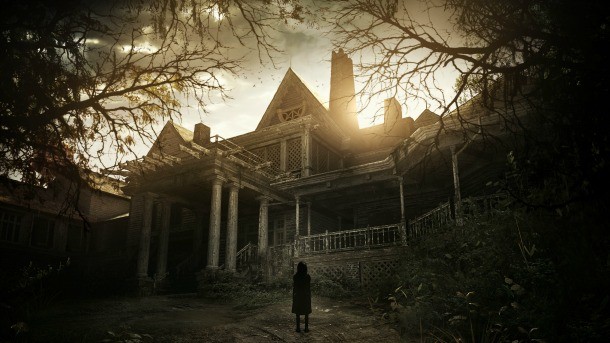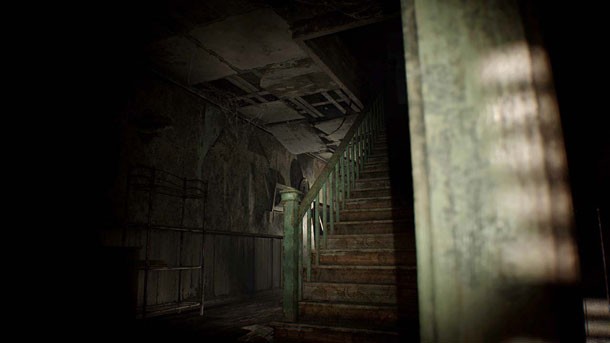Our extra-large special edition is here. Subscribe today and receive the 25% longer issue at no extra cost!
Opinion – Resident Evil 7 Is Best Played In VR

I peer through an open doorway, glancing left and right in fear that Jack Baker, a shovel-wielding maniac, is nearby. Hearing footsteps approaching, I hold my breath. Jack taunts me in the distance, repeating, “Here, piggy piggy…” as he searches for me. He spots me before I can make a run for it. Raising his shovel in a tight grip, I wince while anticipating the pain as he violently swings his weapon at my knees.
But the pain never comes.
I’m swearing repeatedly under my breath, while my girlfriend laughs beside me. I take off the PSVR headset and return to the real world, feeling as though I was just somewhere else entirely.
I was skeptical when I first heard that Resident Evil 7: Biohazard’s 10-hour campaign could be played in virtual reality. It sounded off-putting, especially since VR is notorious for its side effects of motion sickness. I have experienced varying degrees of dizziness with the headset in the past, and I wasn’t convinced that I could withstand playing a full-fledged, triple-A game in VR. But I knew I wanted to try. After taking some time to adjust, it became less of an experiment, transforming into my preferred way to play.
Resident Evil 7 is different from past entries, reinventing the series once again and taking place in first-person. This perspective makes it a perfect fit for VR. You’ll feel sick to your stomach, but that won’t necessarily be from motion sickness. Resident Evil 7 is, without fail, a gross game. With the PSVR headset on, my disgust was amplified. Squeezing through a narrow space, centipedes crawled around and fell on top of me, and I wanted to recoil. When tiny white spiders on a doorway suddenly jumped at me, my first instinct was trying to shake them off my body. Sticking my arm into a murky toilet or into the throat of a headless corpse seemed all that more real, and these are memories I won’t soon forget.
The whole game is terrifying. From the brooding, vomit-worthy atmosphere to its intense jump scares, the experience is best in VR. Resident Evil 7 is still horrific without VR, but to a lesser degree. Whenever playing normally, I would lose that heightened immersion, creating a distance from the terrors so that I felt relatively safe on my couch. With VR, however, I sensed these dangers on a whole new level – from my heart racing to involuntarily screaming or shaking after a jump scare that felt far more real than I’d expect.

I have always been a fan of horror, and what I enjoy best about scary games is that you are the one propelling the action forward. This idea is further explored in VR with its physical movements – you’re not just holding a joystick forward to enter a room, you’re also turning your head left and right to fearfully look around. Climbing ladders was also nerve-wracking, as I tilted my head upwards slowly, trying to catch a glimpse of what awaited me at the top.
Playing in VR demands a lot of courage to face your fears – literally. You can’t cover your eyes with your hands, because a headset is strapped to your face, and neither can you look away. Jump scares are more up close and personal as well. I discovered that opening doors – often very slowly – was among the scarier actions, as you never know what face-to-face horror awaits you on the other side.
Truth is, I could never play Resident Evil 7 without anyone around. I was dedicated to playing it entirely in VR, but it was too terrifying a feat to accomplish alone. Watching someone else play the game too became interesting for how I’d see them physically react to every horror. When entering a darkly lit children’s room, my girlfriend would slow down, not wanting to face what was ahead, and after a long bout of scares she took the headset off, shaking from head to toe.
Resident Evil 7 in VR is most terrifying when it suspends disbelief, tricking me into believing that I’m transported to a nightmarish world. However, it’s not perfect. Wonky VR glitches distracted me every so often, breaking the immersion. Protagonist Ethan’s arms had a tendency to flail inexplicably, or turn into floating, dismembered limbs rather than normal, attached arms. Other times, the headset had trouble tracking my movements, making the entire digital world shake as if there were an earthquake. I was able to find comedic relief with my crazed arms, but the latter caused discomfort. Luckily, it didn’t occur often enough to disrupt my experience entirely.
I discovered turning my head was more effective in keeping motion sickness at bay, rather than using the controller to change the camera view. Some scenes where I was thrown around made me feel woozy, and the first boss battle in particular was a far more dizzying experience than I would have liked. The extended time with the PSVR headset also caused me headaches more than motion sickness, but this can change from person to person.
One of my bigger complaints is that the screen resolution seems blurry and fuzzy, losing the high definition you would have on an HDTV. This was something I was able to look past, however, as large insects flew into my face and I instinctively wanted to swat them away.
It may sound gimmicky, like 3D movies at the theater, but Resident Evil 7 in VR surpasses that ideology with intense scares and a strong sense of immersion I have yet to find elsewhere. Virtual reality still has its flaws and stumbling blocks, but in Resident Evil 7’s case, it doesn’t feel like an afterthought. Instead, it holds promise for future full-length VR games by showing that it is possible to not just make a good horror game, but a terrifying VR experience worth playing.

Get the Game Informer Print Edition!
Explore your favorite games in premium print format, delivered to your door.
- 10 issues per year
- Only $4.80 per issue
- Full digital magazine archive access
- Since 1991









